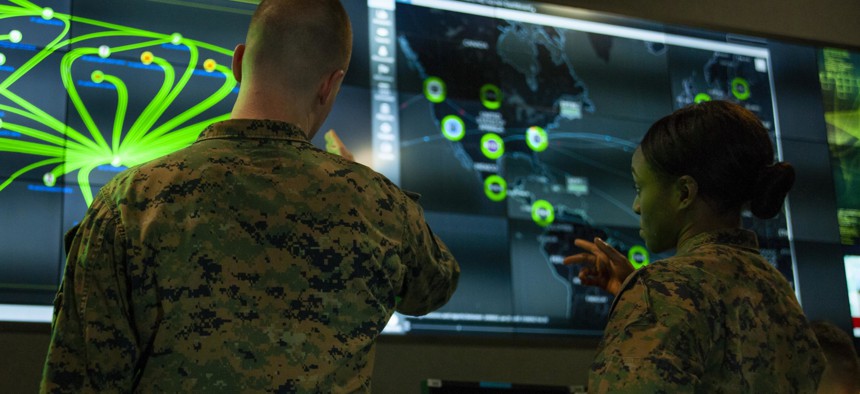
U.S. Marine Corps / Staff Sgt. Jacob Osborne
To Get Better at AI, Get Better at Finding AI Talent
The military branches need to coordinate on goals and means of cultivating people who can advance the use of artificial intelligence.
The Defense Department’s recent efforts to raise its artificial intelligence game have revealed a few obstacles. There are no cohesive goals across the military branches, and there is no way of knowing whether each service has enough people with the right skills. DOD should work with the services to establish AI-specific goals for cultivating technical talent, make it easier for all personnel to learn about AI and put it to use, and enable AI “rock stars” to succeed.
It is currently impossible for the DOD to assess its AI posture, let alone assert leadership in AI. That’s because posture assessment requires measurement. When it comes to its people, no service has clearly defined its “AI workforce,” identified who’s in it, or established ways to measure that they are being appropriately assigned and promoted. There is also no clear way to measure a service’s AI talent needs, or ensure those needs are being met.
But one thing widely believed about DOD and AI is turning out to be untrue. Though the prevailing narrative holds that that the Pentagon is unable to compete for talent, recent research from the Center for Security and Emerging Technology, or CSET, in collaboration with the MITRE Corporation, found that the DOD is a top employer of technical talent in the United States. The problem is many technical experts are hidden, underidentified, and underused.
Our interviews with experts and AI-engaged organizations throughout the DOD shine a light on current challenges with cultivating a corps skilled in AI. People with advanced training or experience in AI-related fields are routinely not assigned to related roles. Personnel that upskilled or trained themselves in technically relevant ways did so on their own time and have limited opportunities to use those skills. Those that do, but are outside of their career track, risk promotion or other advancement. Senior leader champions and what we call “rock stars,” change agents on the leading edge, are actively using their platform as a catalyst for change to elevate the importance of technical expertise, but it remains unclear if they will be successful or what happens when they leave their current assignments.
It is unacceptable for these challenges to be shrugged away as “service culture.” Yes, rising leaders understand the criticality of technical expertise, and this will infuse DOD culture over time. But the DOD cannot wait that long. The Office of the Secretary of Defense, in coordination with the services, must empower its uniformed and civilian talent today.
Empowerment today can happen in three ways. First, each service needs dedicated workforce goals that include AI expertise, and ways to measure it. CSET, for example, considers the full range of technical and non-technical roles involved in designing, developing, and deploying AI. Goals should be actionable and measurable, and reward people with AI skills similar to those with other high-demand skills. Goals should also be part of the unifying vision from OSD; with the Joint Artificial Intelligence Center, or its successor in the Office of the Chief Digital and AI Officer, acting alongside Personnel and Readiness as a coordinator to routinely assess AI posture. That allows every service to take the approach that makes the most sense for them.
Second, services should provide ways for all to participate in innovation related to AI and other emerging technologies. Delineations between uniformed and civilian talent, officer and enlisted service members, operational and non-operational career fields, and ranks within them are imperfect boundaries for where AI and AI-related talent reside. This empowerment includes hosting contests and challenges to demonstrate ideas; facilitating AI-related communities of practice and ideas incubators; upgrading technological infrastructure as needed; enabling assignments that use AI and related skills; and increasing access to industry tours and AI education and training. Services can build on their ability to provide routine professional military education, and create more educational tours for AI-related degrees and certifications. AI and AI-related education or assignments should not limit career opportunities or promotion potential but enhance them.
Third, each service should better support the “AI rock stars” who can push the field forward and draw others to it. These change agents are uniquely positioned to use their skills and expertise to facilitate the elevation of talent with technical skills–including in AI. They are advocates for advancing AI and data-driven capabilities internally and externally, form communities of practice, share best practices and lessons learned, develop and implement innovative software-enabled solutions, and create new assignment and advancement opportunities for technical talent. They need top-level support and resourcing to advance these goals. They should also be strategically assigned to continue advancing these goals, and promoted accordingly.
As the nature of warfare, missions, and force structure evolve, so too should how the DOD thinks about the importance of technical talent. Success in future conflict will require leading in cyber, AI, and other emerging technologies. This requires elevating technical expertise, but doing so in a clear, measurable, and coordinated way. But this cannot happen without a willingness to invest in empowering its best asset–its people. Only then can the DOD claim, and show, it is leading in AI talent.
Diana Gehlhaus is a research fellow at Georgetown University’s Center for Security and Emerging Technology (CSET).
NEXT STORY: The Indo-Pacific Strategy Needs Indo-Specifics



